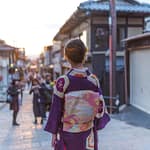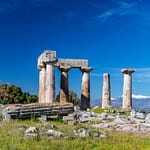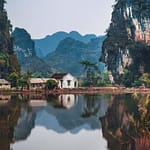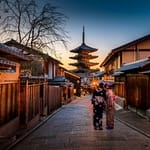Naoshima Travel Plan: Art, Nature, and Hidden Gems
Nestled in the calm waters of Japan’s Seto Inland Sea, Naoshima is a dreamlike destination where contemporary art and serene nature exist in perfect harmony. Just a short journey from Okayama (岡山市), this captivating island makes for an unforgettable day trip—especially for lovers of art, architecture, and coastal beauty.
Renowned worldwide for its avant-garde art museums, open-air installations, and the iconic pumpkin sculptures by Yayoi Kusama, Naoshima offers more than a sightseeing experience—it’s a soulful escape into a living canvas. Whether you’re a design devotee or simply in search of quiet inspiration, this island promises a journey unlike any other in Japan.
In this guide, I’ll share the exact one-day itinerary I followed to explore Naoshima’s highlights, along with insider tips, travel recommendations, and must-see spots to help you get the most out of your visit to Japan’s celebrated ‘art island’.
- Naoshima Travel Plan: Art, Nature, and Hidden Gems
- What Makes Naoshima Unmissable?
- How to Get to Naoshima: A Passage to the Island of Art
- A Day Adrift in the Dreamscape of Naoshima
- Cross the island to the museum area, where art and ocean views collide.
- Satisfy your art-loving soul in every gallery and corner.
- Discover outdoor art in stunning scenery
- Discover the charm of Naoshima’s Honmura Port Area
- Return to Minayoura Port — your next destination awaits.
- Top Travel Tips for a Perfect Day Trip to Naoshima Island
- Final Thoughts on Naoshima
What Makes Naoshima Unmissable?
An Island Where Art and Earth Converse, Naoshima isn’t merely a place you visit—it’s a place that changes the way you see. Set adrift in Japan’s Seto Inland Sea, this quiet island pulses with artistic life, where world-class museums and site-specific installations nestle gently into the natural landscape.
Here, art doesn’t hang on walls—it lives in concrete sanctuaries, reflects on rippling waves, and waits in hidden alleys. The island invites you to wander slowly, to let silence speak, and to find inspiration in both creation and stillness.
To visit Naoshima is to step into a space where visionaries like Tadao Ando and Yayoi Kusama have shaped a world that blurs the line between the manmade and the organic, the intellectual and the emotional. It’s not just a journey across water—it’s a passage into perspective.
How to Get to Naoshima: A Passage to the Island of Art
To reach Naoshima, the tranquil jewel where contemporary art whispers to the sea, your journey begins not just with a ticket but with intention. Most travelers start from Okayama, Osaka, or Tokyo—cities bound to Naoshima by the swift and silent Shinkansen, which whisks you to Okayama Station, your threshold to the Seto Inland Sea. From there, take the local JR Uno Line (¥560, ~25 min), a peaceful ride through towns where the modern world softens into countryside charm, and step off at Uno Station. Just beyond lies Uno Port, where ferries—slow and fast—wait like floating galleries to carry you to Naoshima’s Miyanoura or Honmura Port (¥300 one-way, or ¥570 round-trip, ~20–30 min). If you’re venturing from Shikoku instead, ferries from Takamatsu (¥520 for the standard ferry, ~1 hr or ¥1,220 for the high-speed boat, ~35 min) offer another scenic passage across the Inland Sea. Take note: ferries sleep when night falls, so plan thoughtfully and wander slowly. This is not just transit—it is a ritual, a soft unfolding toward an island where concrete breathes, pumpkins glow, and the soul remembers how to see.
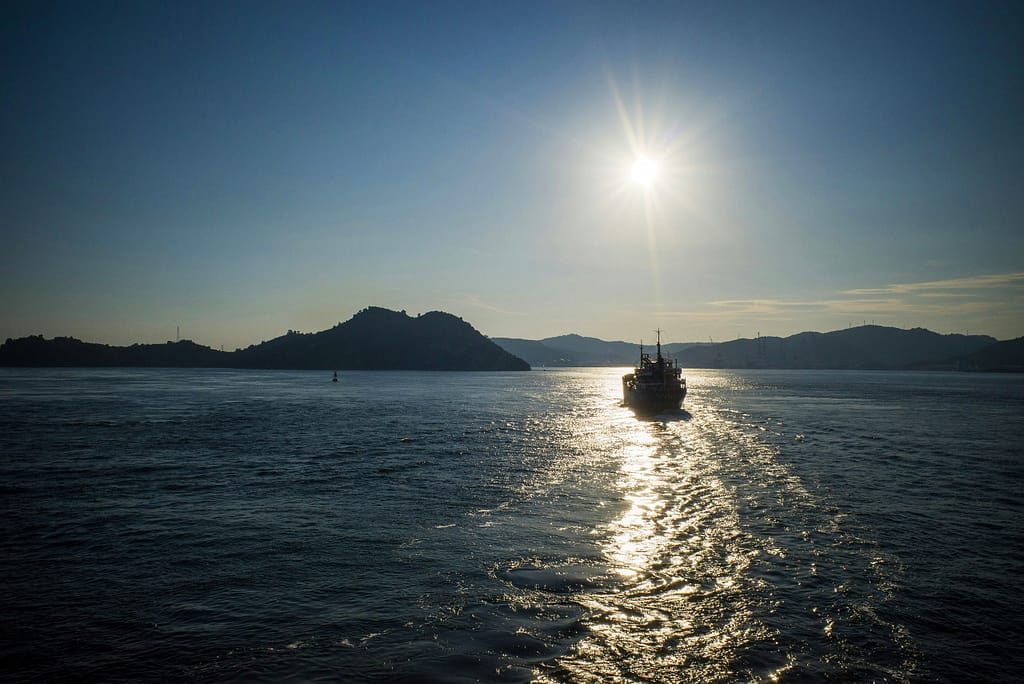
Seto Inland Sea.
A Day Adrift in the Dreamscape of Naoshima
Start your journey in the heart of Naoshima’s harbor soul.
Upon your arrival at Miyanoura Port, the gateway to Naoshima, you’ll quickly find yourself immersed in a world where art meets island charm. Your first stop should be Marine Station Naoshima (海の駅なおしま)—a modest yet welcoming hub offering practical essentials like lockers, a cozy shop stocked with local snacks and drinks, and a selection of brochures and maps to guide your journey. Just steps outside, transportation is a breeze: a convenient bus stop, a taxi stand, and a handful of bike rental shops await, giving you flexible options for exploring the island. (Personally, I opted to discover Naoshima by bus and on foot, though there are several other enjoyable ways to get around—see the travel tips section below.)
Before venturing further inland, take a moment to soak in some of Naoshima’s iconic landmarks right near the port. Most striking is Yayoi Kusama’s Red Pumpkin (赤かぼちゃ)—a whimsical, polka-dotted sculpture that has become an emblem of the island’s artistic spirit. Just a short walk away, you’ll encounter the Naoshima Pavilion (直島パヴィリオン), a visually captivating, geometric installation designed by architect Sou Fujimoto. And for a quiet touch of tradition amid the modern art, don’t miss the charming Sumiyoshi Shrine (住吉神社) nestled nearby.
The Red Pumpkin: Kusama’s joyful burst of art on Naoshima’s portside.
The moment you step off the ferry at Miyanoura Port, Naoshima’s vibrant spirit greets you with open arms. Before venturing further into the island, take time to explore the welcoming hub of Marine Station Naoshima (海の駅なおしま). This compact yet convenient space offers coin lockers, a quaint shop stocked with local snacks and refreshing drinks, and an array of brochures and maps to help orient your journey. Just outside, practical travel options await—a bus stop, a taxi stand, and several bike rental shops make getting around the island a breeze. (While I personally chose to explore Naoshima by bus and on foot, other transportation methods are available—more on that in the travel tips below.)
Before leaving the port area, be sure to pause for one of Naoshima’s most iconic sights: Yayoi Kusama’s Red Pumpkin (赤かぼちゃ). This bold, polka-dotted sculpture, whimsical yet powerful, has become a beloved symbol of the island’s artistic soul. Just a short walk away, you’ll find the Naoshima Pavilion (直島パヴィリオン)—a visually striking, faceted structure designed by architect Sou Fujimoto that beautifully reflects both the sea and the sky. For a quieter, more traditional moment, step into the peaceful grounds of the nearby Sumiyoshi Shrine (住吉神社), a small but spiritually rich site tucked into the port’s landscape.
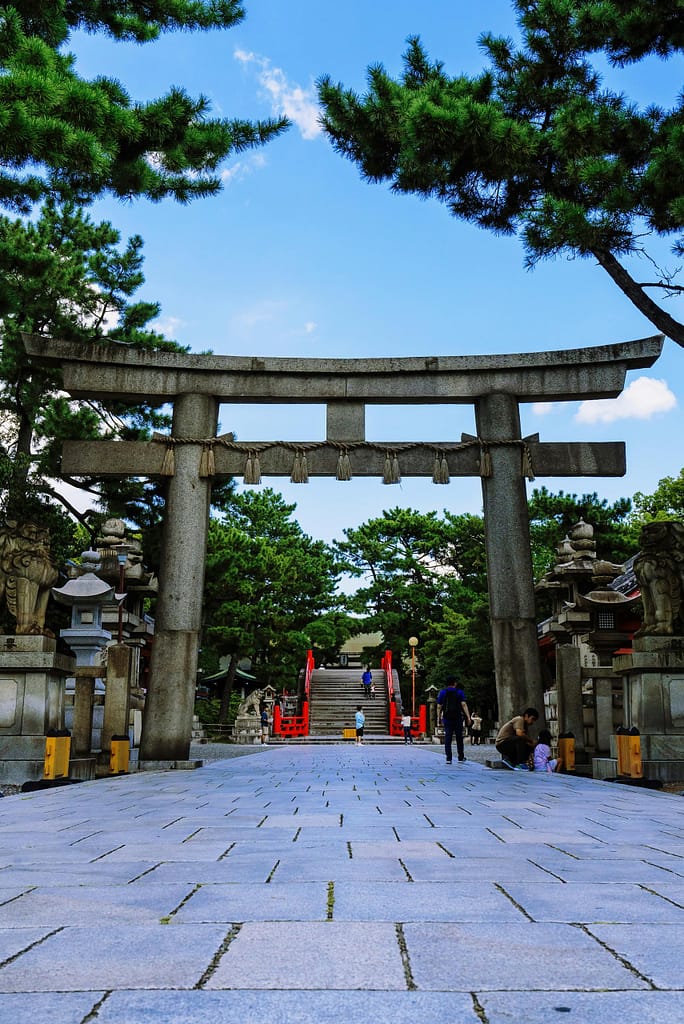
Sumiyoshi Shrine
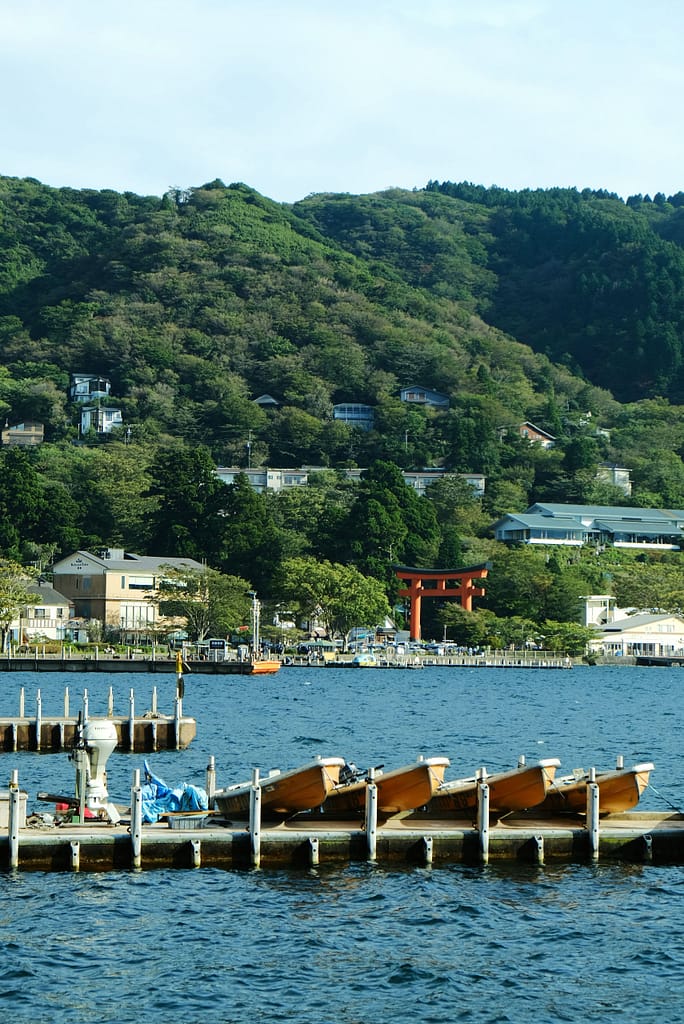
Miyanoura Port
Cross the island to the museum area, where art and ocean views collide.
After boarding the local town bus at stop no. 2, conveniently located beside Marine Station Naoshima, settle in for a scenic ride across the island. As the bus winds through Naoshima’s quiet hills and coastal roads, you’ll be treated to sweeping views of the countryside and sparkling shoreline. Hop off at the Tsutsuji-so bus stop, just across from Gotanji Beach (琴弾地海水浴場), where a breathtaking vista unfolds—crystal-clear waters stretching out to the horizon and the striking Torii gate of Ebisu Shrine (恵美須神社 鳥居) standing gracefully against the sea.
Just a short walk from the stop, you’ll encounter one of Naoshima’s most beloved symbols: Yayoi Kusama’s Yellow Pumpkin (南瓜), perched at the edge of a pier like a surreal guardian of the coast. The scene here is truly enchanting—the rhythmic sound of gentle waves, the warm sea breeze, and the expansive ocean views create a serene, almost meditative space. It’s the perfect spot to pause, reflect, and let the island’s quiet magic sink in.
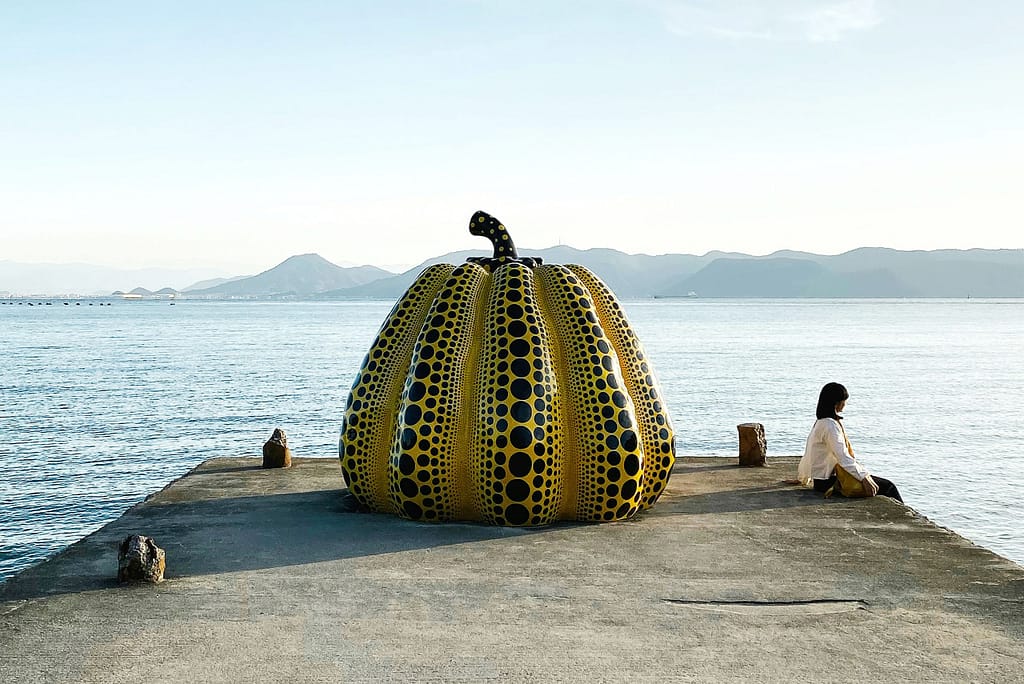
Kusama’s Yellow Pumpkin
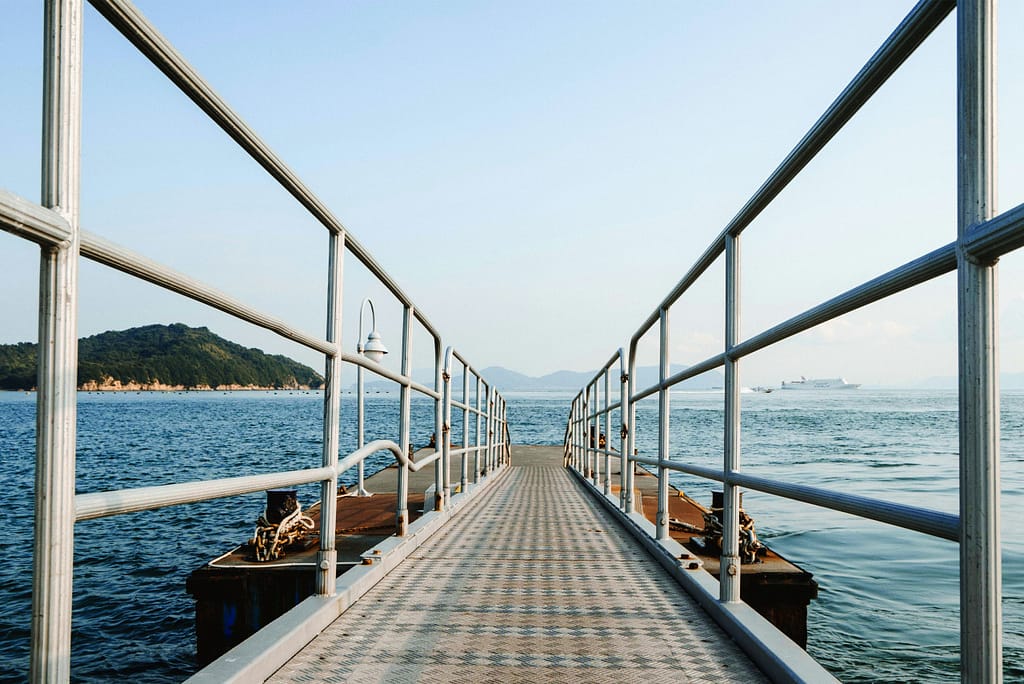
Seto Inland Sea Port
Just a short stroll from Kusama’s Yellow Pumpkin, a vibrant burst of color awaits—a series of dynamic sculptures by Dutch artist Karel Appel, nestled beside the Benesse House Shop and Spa. These bold, abstract forms add a playful contrast to the serene coastal setting. Wandering through this area, I found myself captivated not only by the expressive energy of the artworks but also by the sweeping views of the Seto Inland Sea, where sky and water blur into a breathtaking horizon. It’s a place where art, nature, and tranquility effortlessly converge.
Satisfy your art-loving soul in every gallery and corner.
Naoshima is nothing short of a sanctuary for lovers of contemporary art. During my visit, I set out to explore three of the island’s renowned museums—each offering a unique experience. Let’s begin with the first: the Benesse House Museum.
Opened in 1992 and masterfully designed by celebrated architect Tadao Ando, the museum is a striking fusion of art, architecture, and nature. Perched on a hillside overlooking the sea, it seamlessly integrates indoor gallery spaces with outdoor installations. As you wander through, you’ll encounter an eclectic blend of sculpture, photography, and painting, all thoughtfully placed to engage with both the viewer and the surrounding landscape. The views alone—panoramic and soul-stirring—are worth the visit.
The museum welcomes visitors daily from 9:00 AM to 6:00 PM, and admission is ¥1,500 at the door or ¥1,300 with an advance online ticket.
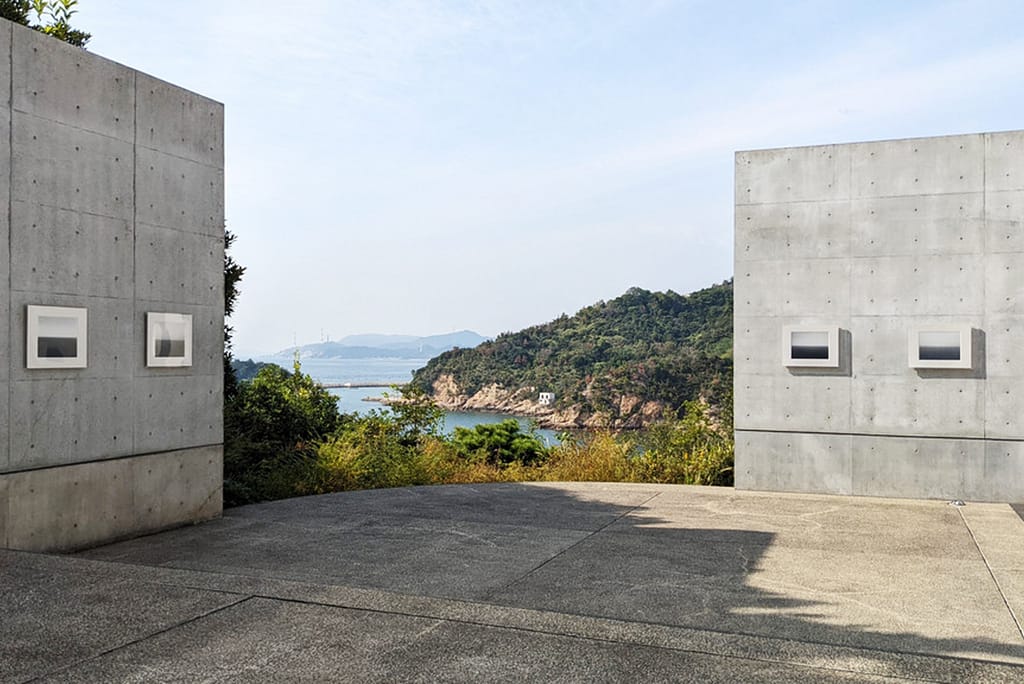
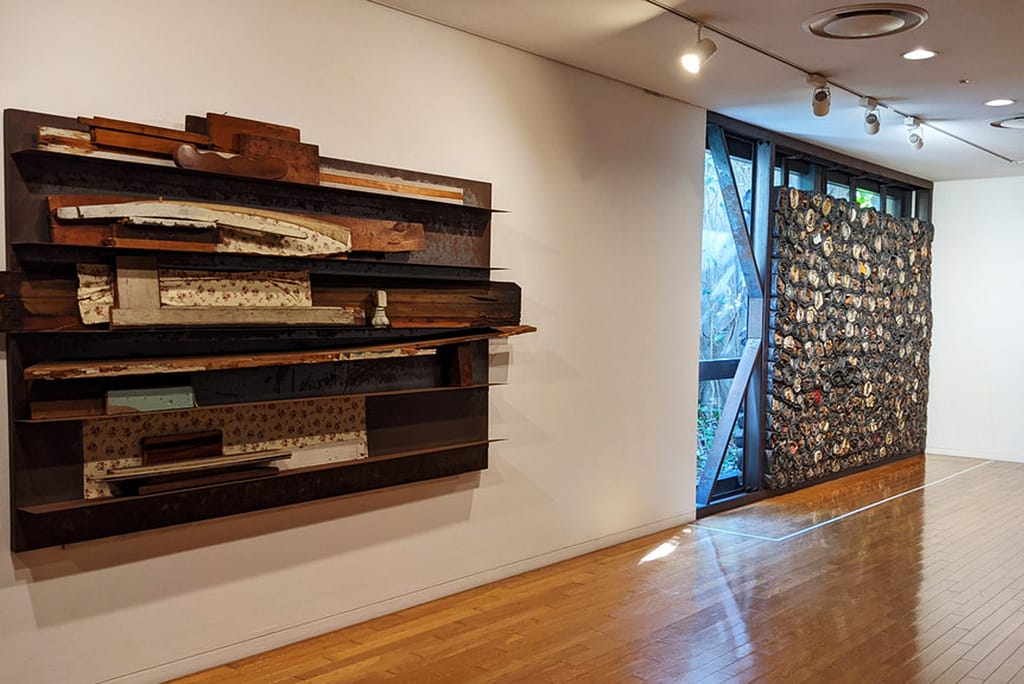
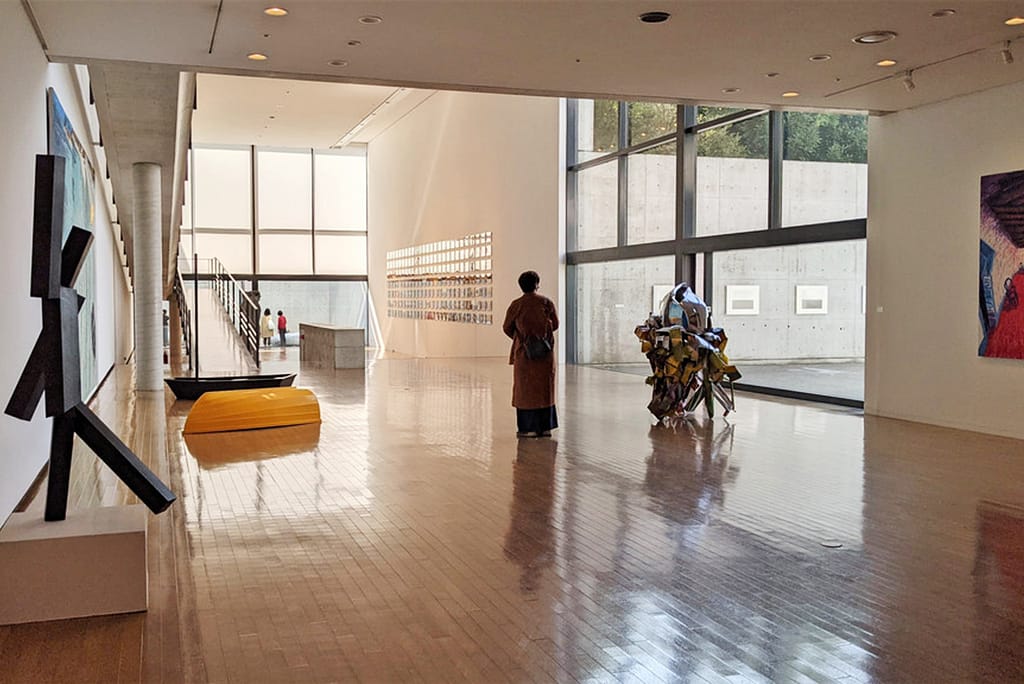
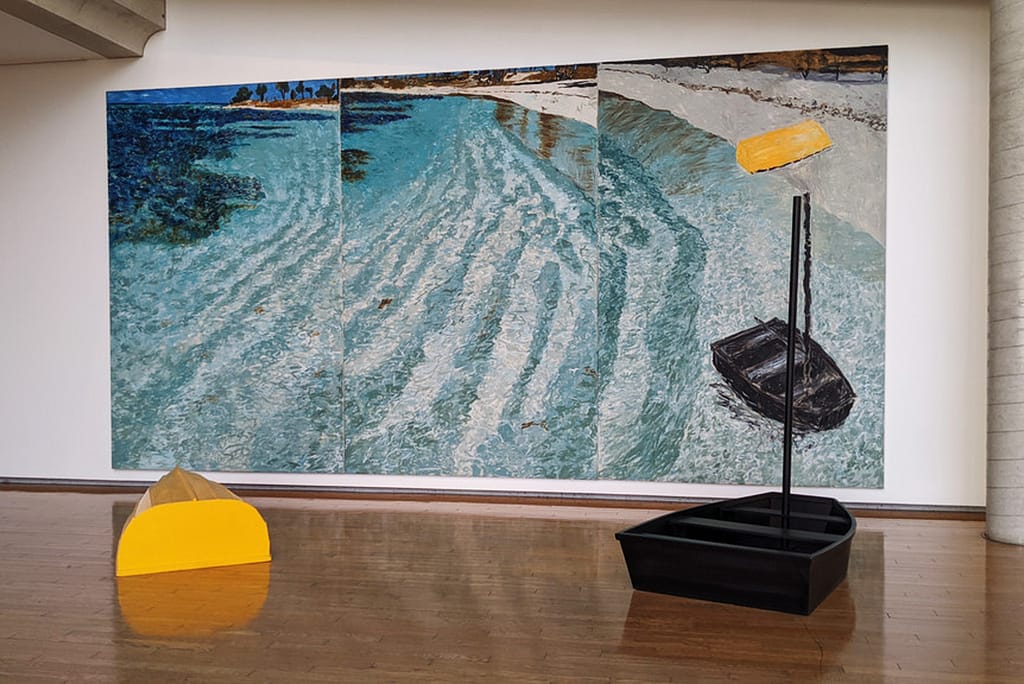
Yellow and Black Boats by Jennifer Bartlett (1985)
Next on my journey was the Valley Gallery—a more intimate, yet utterly captivating space tucked within the Benesse Art Site. Designed once again by Tadao Ando, this smaller gallery stands out for its poetic dialogue between architecture, art, and the natural landscape. Here, you’ll encounter compelling installations by Yayoi Kusama and Tsuyoshi Ozawa, each piece thoughtfully placed to interact with light, shadow, and the surrounding environment.
This spot quickly became a favorite. Especially mesmerized by how the sunlight danced across the shimmering metal spheres, creating a constantly shifting reflection that blurred the lines between sky, earth, and sculpture. The gallery beautifully balances modern form and traditional elements, offering a contemplative space where nature and structure coexist in quiet harmony.
Though often overlooked, the Valley Gallery is actually included with Benesse House Museum admission—a hidden gem well worth your time. It’s open daily from 10:00 AM to 5:00 PM, and closed on Mondays, so be sure to plan accordingly.
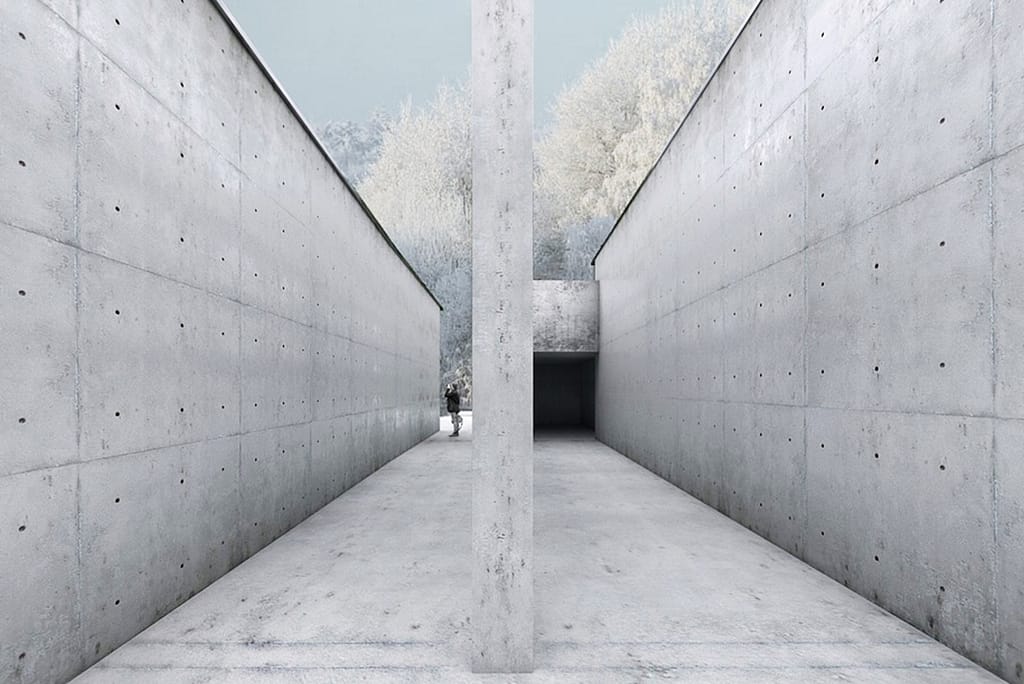
Entrance to the Chichu Art Museum
A true crown jewel of Naoshima’s art scene is the Chichu Art Museum (地中美術館)—an architectural and experiential marvel designed by Tadao Ando. Built largely underground to harmonize with the natural landscape, the museum is a masterclass in minimalism, light, and space. Within its serene, concrete walls, you’ll encounter profound works by Claude Monet, James Turrell, and Walter De Maria—each presented in a way that invites quiet reflection and a deeper connection to the elements.
What sets the Chichu Art Museum apart is its breathtaking use of natural light. Rather than simply illuminating the space, light becomes part of the experience itself—subtly shifting throughout the day and seasons, transforming the artworks and the atmosphere moment by moment. It’s a space that lives and breathes with the world outside. Photography is not permitted inside, preserving the contemplative and almost sacred atmosphere of the museum.
The Chichu Art Museum is open from 10:00 AM to 5:00 PM, and is closed on Mondays. Admission costs ¥2,800 on-site or ¥2,500 if booked in advance online for weekday visits. On weekends and public holidays, prices are slightly higher at ¥3,000 on-site and ¥2,700 in advance.
Important Tip: If you’re planning to visit the Chichu Art Museum, I highly recommend booking your ticket in advance. Entry is timed, and the number of visitors per slot is strictly limited to preserve the tranquil atmosphere. Arriving without a reservation may mean long waits—or worse, no availability during your preferred time. To make the most of your visit and avoid disappointment, be sure to secure your spot ahead of time.
Discover outdoor art in stunning scenery
One of the most memorable parts of my time on Naoshima was the walk between the island’s art museums. This peaceful, meandering route offered far more than just a way to get from one gallery to the next—it was a journey in itself. With sweeping coastal vistas, haunting art installations tucked into unexpected corners, and the occasional encounter with friendly island cats, the walk felt both contemplative and quietly magical.
The stretch from Gotanji Beach to the Chichu Art Museum takes about 40 minutes at a relaxed pace, allowing plenty of time to soak in the atmosphere. It’s worth noting that private vehicles and bicycles are not permitted on this scenic path, which helps preserve its tranquil character. For those who prefer not to walk, a free shuttle bus runs between Tsutsuji-so and the Chichu Art Museum, though service is limited to around 1–2 buses per hour.
After making my way back to the Tsutsuji-so bus stop, I hopped on the town bus once again and headed toward my next stop: the Honmura port area, ready to continue exploring Naoshima’s artistic soul.
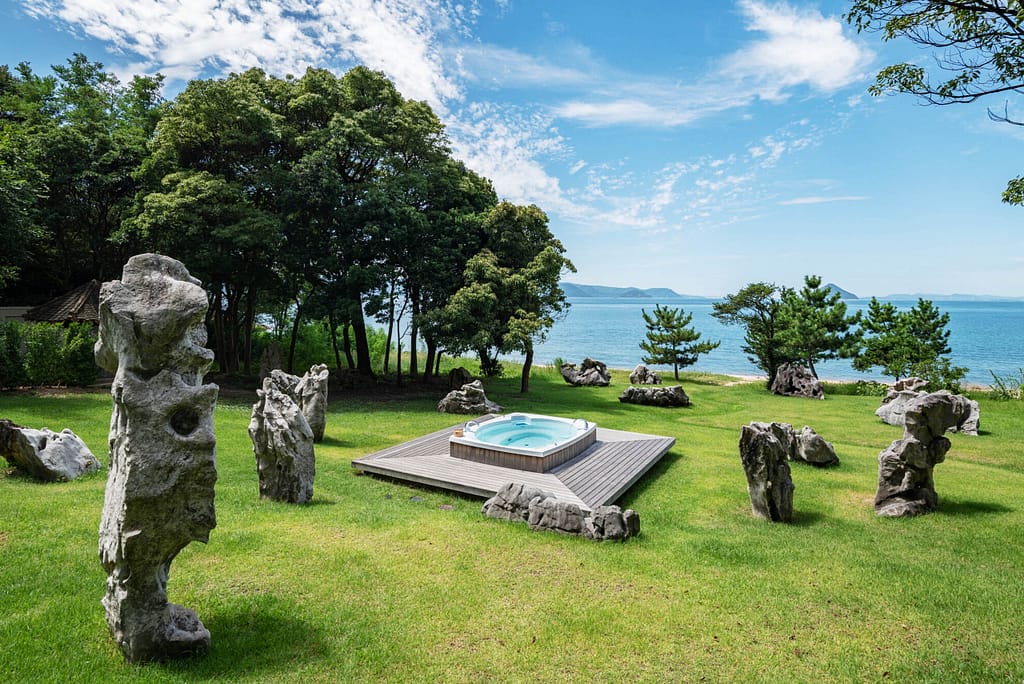
Cultural Melting Bath situated on Naoshima’s coastline
Discover the charm of Naoshima’s Honmura Port Area
The Honmura Port Area (本村) offers a serene retreat, with its quaint fishing village charm, quiet streets, and traditional wooden houses. If you’re traveling by bus, you can easily hop off at the Yakuba-mae or Nokyo-mae bus stops, both of which are conveniently located.
We thoroughly enjoyed wandering through this peaceful neighborhood, which is a photographer’s dream—picturesque scenes unfold around every corner. As someone who’s always drawn to shrines and temples, We found solace in visiting the tranquil Gokurakuji Temple (極楽寺) and the serene Hachiman Shrine Haiden (八幡神社), both offering a quiet sanctuary amidst the island’s natural beauty.
No visit to Honmura would be complete without stopping by the Honmura Lounge & Archive—a great spot for picking up local souvenirs, gathering tourist information, or purchasing tickets for attractions in the area. If you go there, You should also explored Naoshima Plan 2019 ‘The Water’, an architectural marvel by Hiroshi Sambuichi that celebrates the dynamic beauty of two elements in motion: wind and water. This structure, with its thoughtful integration of nature, is a striking reminder of Naoshima’s commitment to merging art and environment.
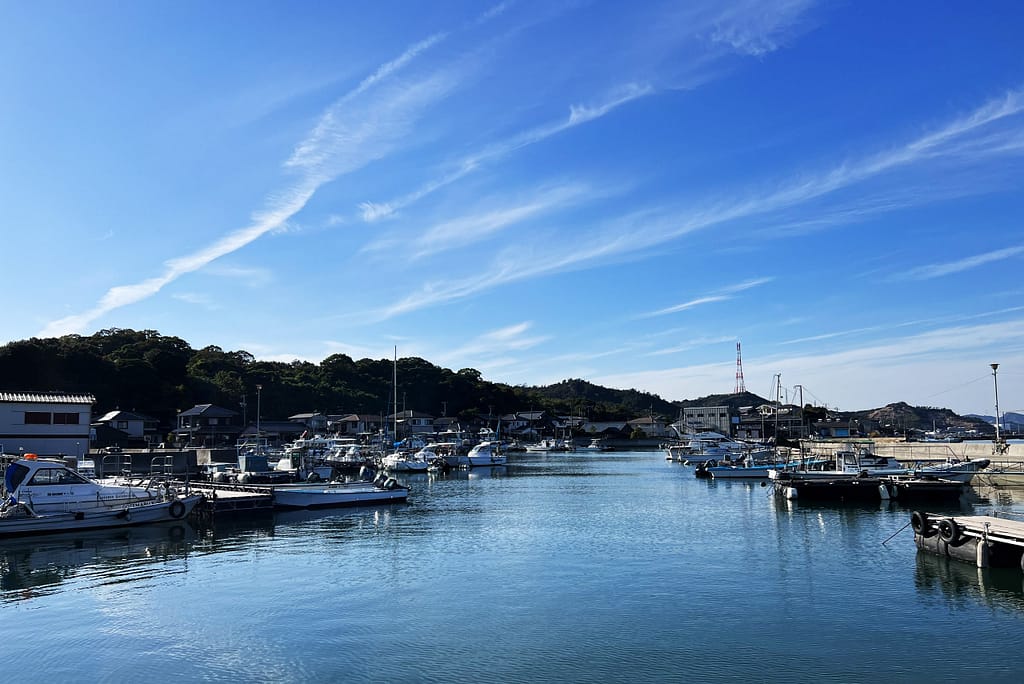
Honmura Port
The Art House Project offers a fascinating exploration where historic houses have been reimagined as immersive art installations. Each residence is a one-of-a-kind work of art, created by different artists to offer a personal, intimate encounter with contemporary creativity. For a modest fee, you can visit five of these unique art houses by purchasing a multi-site ticket, which grants access to Kadoya, Go’o Shrine, Ishibashi, Gokaisho, and Haisha. Tickets are ¥1,200 online or ¥1,400 on-site. Additionally, there are more art house projects available for a separate fee, such as Minamidera (featuring James Turrell’s mesmerizing exhibit) and Kinza, each offering a deeper dive into the intersection of art, architecture, and space.
Another noteworthy stop is the Ando Museum, a modest yet profound tribute to the work of Tadao Ando, the globally acclaimed architect. It’s the perfect place to learn about Ando’s minimalist design philosophy and how his work has shaped modern architecture. Admission is ¥600 if purchased online or ¥700 at the door.
Return to Minayoura Port — your next destination awaits.
After a fulfilling day of exploring the artful landscapes of Naoshima, make your way back to Miyanoura Port to catch the ferry to your next destination.
If time allows before your departure, consider a relaxing visit to the Naoshima Public Bath—an imaginative and inviting bathhouse designed by renowned artist Shinro Ohtake. This one-of-a-kind sento features vibrant mosaics, quirky details, and an atmosphere that blends art with tradition—offering the perfect setting to unwind and reflect on your day.
The bathhouse is open daily from 1:00 PM to 9:00 PM, with Mondays closed. Admission is ¥600, and tattoos are welcome.
Top Travel Tips for a Perfect Day Trip to Naoshima Island
Best Time to Visit
Naoshima is a year-round destination, but to truly appreciate its stunning landscapes and open-air art installations, it’s best to visit on a sunny—or at least dry—day. Clear weather enhances the island’s natural beauty and allows for a more enjoyable experience outdoors.
Avoid visiting on Mondays, as many of Naoshima’s top attractions, including some museums and galleries, are closed.
If you’re planning your trip in 2025, consider aligning it with the Setouchi Triennale (Setouchi International Art Festival), which runs from April to November. This globally renowned event is held in three seasonal sessions—spring, summer, and autumn—and showcases contemporary art installations across the Seto Inland Sea, with Naoshima as one of its central stages. It’s a must for art lovers and cultural explorers alike.
Another exciting highlight for 2025 is the grand opening of the Naoshima New Museum of Art, designed by acclaimed architect Tadao Ando. Set to open in May 2025, this hilltop museum near the Honmura district promises to be a significant addition to the island’s already world-class art scene.
How to Travel Around Naoshima Like a Local
Naoshima may be a small island, but its hilly terrain makes local transportation a convenient option for exploring comfortably. While it’s possible to get around on foot, combining walking with other transport methods can help you make the most of your visit.
You’ll find buses, taxis, and bicycle rental shops near Miyanoura Port, offering easy access to the island’s key attractions. Although I personally enjoy the combination of walking and using the local bus, renting a bike is a popular and flexible way to explore Naoshima at your own pace—especially for those who enjoy a bit of adventure.
For the best experience, I highly recommend checking out the Official Area Map provided by the Naoshima Tourism Association. It’s an excellent resource filled with practical information to help you choose the mode of transport that best suits your travel style—and to adapt any itinerary to fit your pace.
Final Thoughts on Naoshima
Whether you’re making a quick day trip from Okayama or Takamatsu, or choosing to spend a few days immersed in its quiet charm, Naoshima offers something deeply enriching. The island invites you to slow down, breathe deeply, and engage with art in ways that feel both personal and profound—whether through the iconic installations scattered along the shoreline or the minimalist architecture nestled into the landscape.
Every corner of Naoshima holds a thoughtful balance of creativity and calm, making it not just a place to visit, but one to feel and reflect. Whether you’re strolling through the Chichu Art Museum, cycling past coastal views, or enjoying a quiet moment at a local café, Naoshima has a way of staying with you—leaving you both inspired and renewed long after you leave its shores.
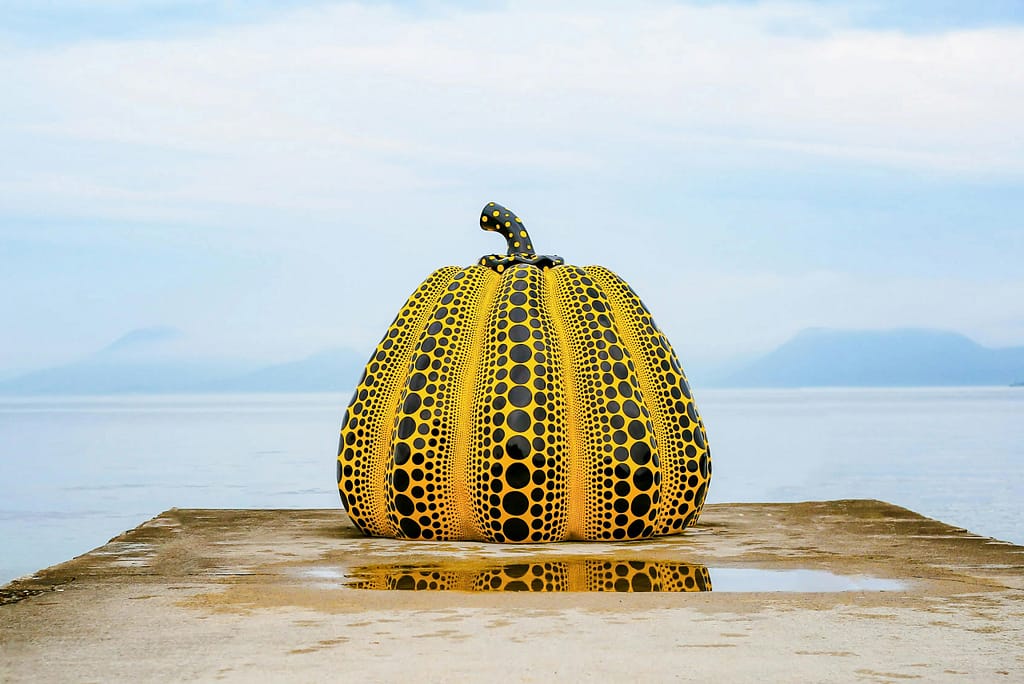
Yellow Pumpkin Sculpture on Naoshima Pier
- Naoshima Travel Plan: Art, Nature, and Hidden Gems
- What Makes Naoshima Unmissable?
- How to Get to Naoshima: A Passage to the Island of Art
- A Day Adrift in the Dreamscape of Naoshima
- Cross the island to the museum area, where art and ocean views collide.
- Satisfy your art-loving soul in every gallery and corner.
- Discover outdoor art in stunning scenery
- Discover the charm of Naoshima’s Honmura Port Area
- Return to Minayoura Port — your next destination awaits.
- Top Travel Tips for a Perfect Day Trip to Naoshima Island
- Final Thoughts on Naoshima

